Oracle® Enterprise Manager Ops Center
Creating Server Pool for Oracle VM Server for SPARC Guide
12c Release 1 (12.1.0.0.0)
E27353-01
May 2012
This guide provides an end-to-end example for how to use Oracle Enterprise Manager Ops Center.
Introduction
Using Oracle Enterprise Manager Ops Center, you can create a server pool for Oracle VM Server for SPARC.
A server pool is a group of one or more virtualized hosts with the same processor architecture that has access to the same virtual and physical networks, and storage resources. Server pools provide load balancing, high availability capabilities, and sharing of some resources for all members of the pool.
You must select the policies in the server pool to manage the underutilized and overutilized servers in the pool:
-
Placement Policy – This policy decides the preferred virtualization host in the server pool to place the logical domains.
-
Auto Balancing Policy – This policy performs load balancing of the server pool automatically at set intervals.
The version of Oracle VM Server for SPARC that you install depends on the type of server hardware version installed. For a list of compatible hardware and software versions, see Related Articles and Resources for Oracle VM Server for SPARC documentation website.
What You Will Need
You need the following before you can create a Server pool for Oracle VM Server for SPARC.
-
Two servers installed with Oracle VM Server for SPARC 2.1 in a healthy state and should not be associated with any server pool.
-
A NAS storage library to deal with the NFS file system and to store the logical domain metadata and a SAN storage library for virtual disk storage of logical domains.
-
Networks to be attached to the server pool are in default network domain.
-
Placement policy and Auto balancing policy to manage the load of the virtualization servers in the server pool.
See Oracle Enterprise Manager Ops Center Feature Reference Guide for more information on policies.
-
Virtualization administrator to create and manage the server pool.
Hardware and Software Configuration
This section defines the hardware and software details for installing Oracle VM Server for SPARC 2.1 version on Sun SPARC Enterprise T5120 Server. The configuration might change according to the hardware and firmware versions that you use.

Description of the illustration systems_ldoms.png
-
Server Model – Sun SPARC Enterprise T5120 Server
-
Processor – SPARC-SUN4V, Sun, 1165 MHz, 64 Total CPU Threads, 8 Core(s)
-
Memory – 32 GB
-
System firmware – 7.4.0.b
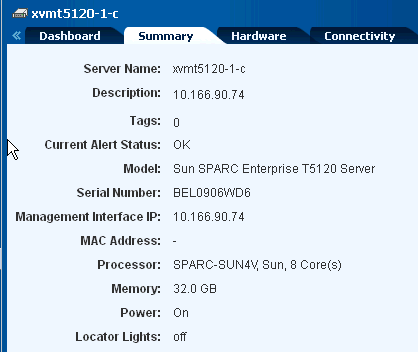
Description of the illustration server_config.gif
Use Oracle Solaris 10 operating system to install Oracle VM Server for SPARC 2.1 version. Upload or import the operating system image to a storage library in Oracle Enterprise Manager Ops Center.
Create a Server Pool for Oracle VM Server for SPARC
Oracle Enterprise Manager Ops Center initiates a wizard that collects information about the servers, storage and network resources, and placement policies to create a server pool.
This example creates a server pool for Oracle VM Servers xvmt5120-1 and xvmt5120-2 for SPARC.
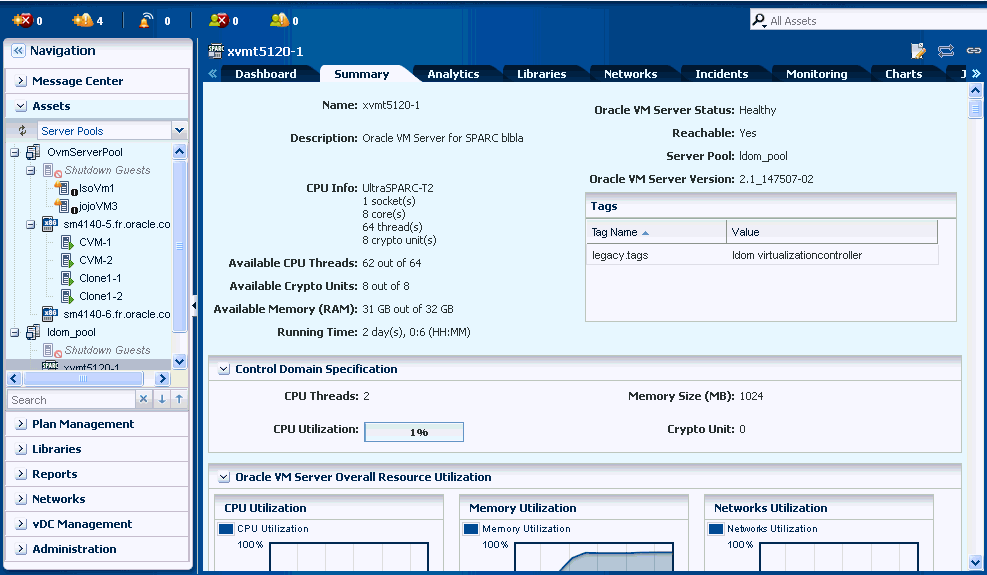
Description of the illustration summary_serverpool.gif
-
Select Server Pools in the Assets drawer of the Navigation pane.
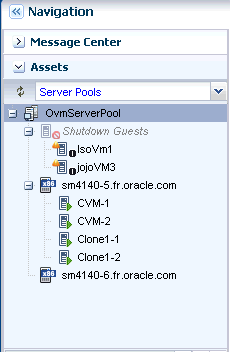
Description of the illustration serverpools.gif
-
Click Create Server Pool in the Actions pane. The Create Server Pool wizard is displayed.

Description of the illustration create_serverpool.gif
-
Specify the following server pool identification information, then click Next.
-
Enter a name and description for the server pool.
-
Select Oracle VM Server - SPARC from the Virtualization Technology menu.
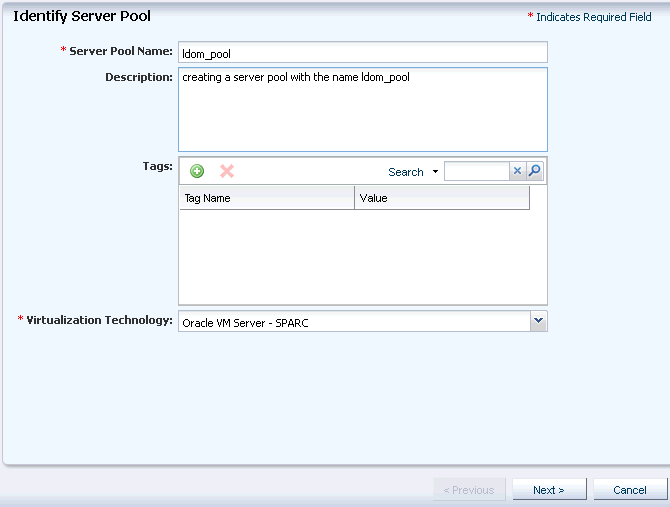
Description of the illustration identify_serverpool.gif
-
-
Select the two Oracle VM Servers to add to the server pool, then click Next.
Oracle VM Servers display the CPU architecture, type, and frequency. Select the Oracle VM Servers to add to the new server pool.
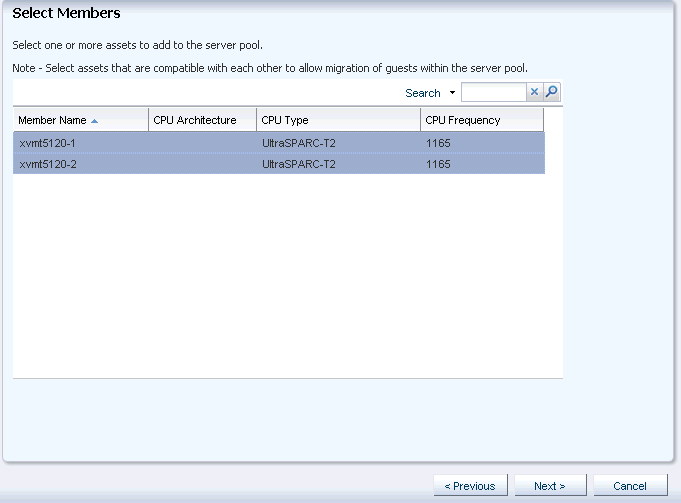
Description of the illustration select_members.gif
-
Select the default network domain to associate with the server pool, then click Next.
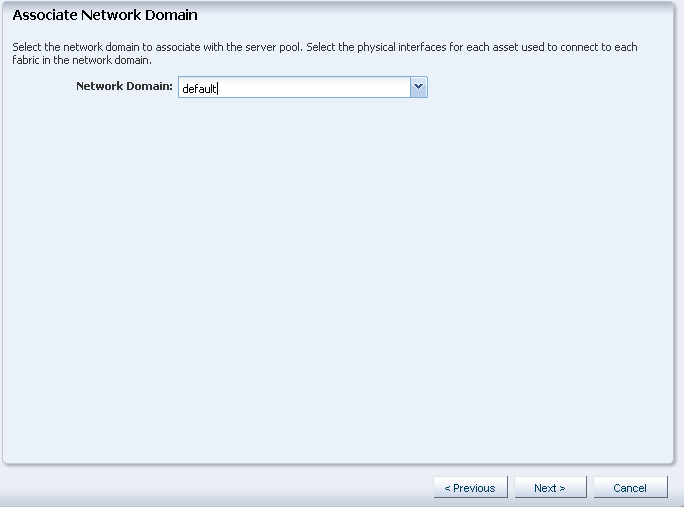
Description of the illustration associate_netdomain.gif
-
For default network domain, click the Add Network icon to add the networks that are declared and managed in Oracle Enterprise Manager Ops Center to associate with the servers in the server pool, then click Next.
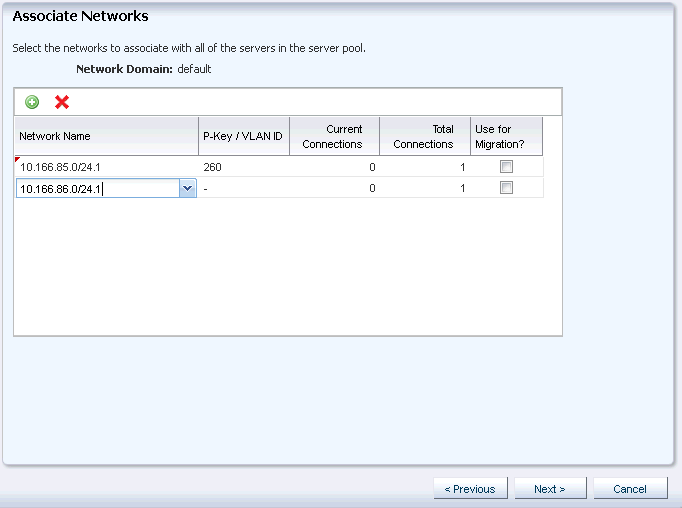
Description of the illustration associate_networks.gif
-
For each network connection, provide the connection details, then click Next.
-
Specify the NIC and IP address for each network connection.
-
Select Use Static IP to allocate an IP address for the network connection.
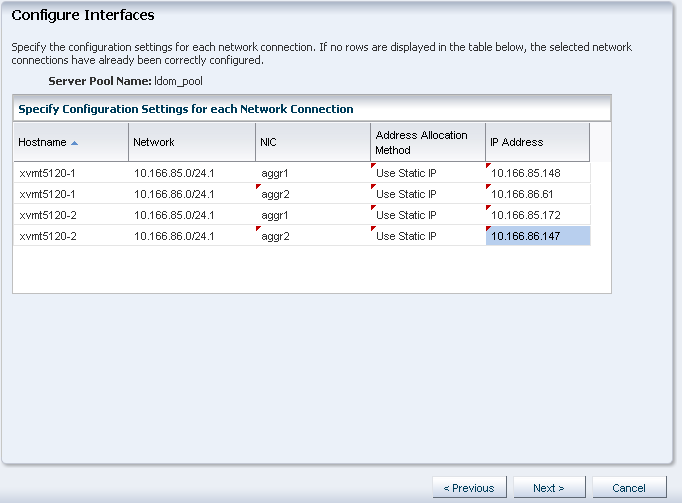
Description of the illustration configure_interfaces.gif
-
-
Storage libraries that are reachable from the selected members of the pool are displayed. Select a NAS and a SAN storage library to associate with the server pool, then click Next.
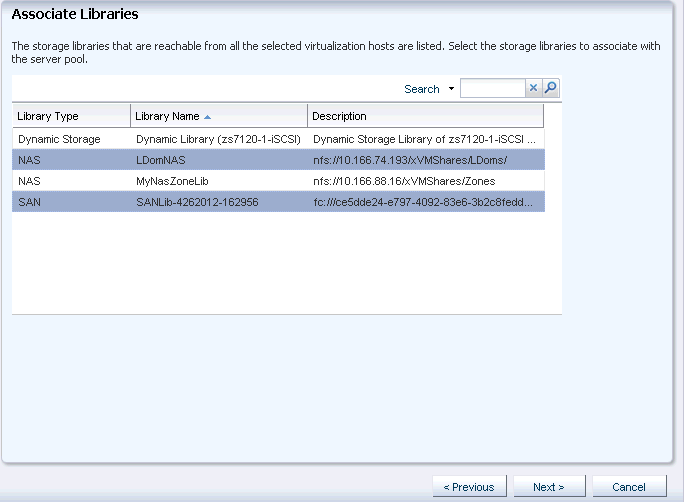
Description of the illustration associate_libraries.gif
-
Select the placement policy – Place guest on Oracle VM Server with lowest relative load and the auto balancing policy – Do not auto - balance the server pool, then click Next.
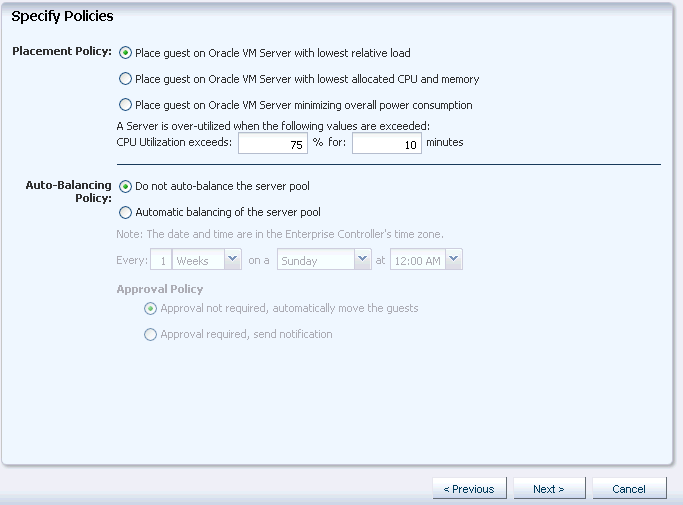
Description of the illustration specify_policies.gif
-
Review the server pool information, then click Finish to create the server pool.

Description of the illustration summary.gif
After the creation of the server pool, you can see the server pool for Oracle VM Server for SPARC in the Navigation pane.
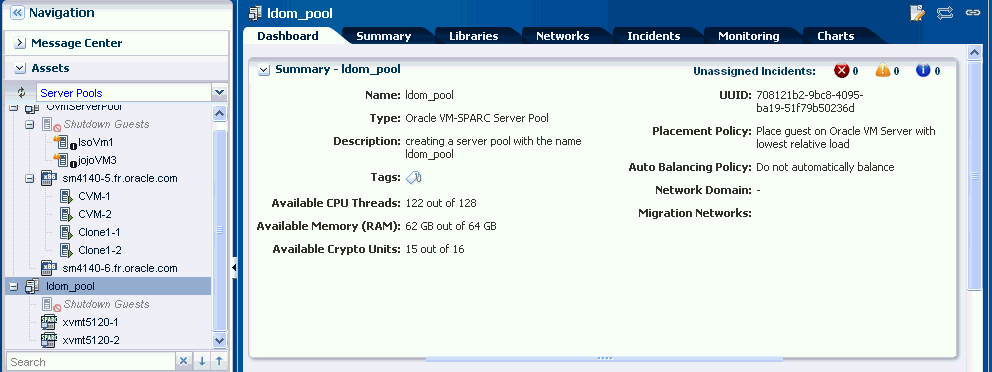
Description of the illustration ldom_pool_details.gif
What's Next?
After creating the server pool for Oracle VM Server for SPARC, the next step is to manage the resources in the server pool. Oracle Enterprise Manager Ops Center provides the following management features:
-
Edit server pool parameters
-
Add virtualization hosts
-
Associate network domains
-
Attach networks
-
Associate libraries
-
Create logical domains
-
Migrate logical domains
-
Balance resources
-
Delete server pool
Related Articles and Resources
For more information on creating a server pool for Oracle VM server for SPARC, see the following:
-
Oracle Enterprise Manager Ops Center Feature Reference Guide
-
Oracle Enterprise Manager Ops Center Configuring and Deploying Oracle VM Server for SPARC Guide
-
Oracle Enterprise Manager Ops Center Configuring and Installing Logical Domains Guide
-
See
http://docs.oracle.com/cd/E27363_01/index.htmfor Oracle EnterpriseManager Ops Center documentation.
-
See http://docs.oracle.com/cd/E23120_01/index.html for Oracle VM Server for SPARC 2.1 version documentation.
Documentation Accessibility
For information about Oracle's commitment to accessibility, visit the Oracle Accessibility Program website at http://www.oracle.com/pls/topic/lookup?ctx=acc&id=docacc.
Oracle customers have access to electronic support through My Oracle Support. For information, visit http://www.oracle.com/pls/topic/lookup?ctx=acc&id=info or visit http://www.oracle.com/pls/topic/lookup?ctx=acc&id=trs if you are hearing impaired.
Oracle Enterprise Manager Ops Center Creating Server Pool for Oracle VM Server for SPARC Guide, 12c Release 1 (12.1.0.0.0)
E27353-01
Copyright © 2007, 2012, Oracle and/or its affiliates. All rights reserved.
This software and related documentation are provided under a license agreement containing restrictions on use and disclosure and are protected by intellectual property laws. Except as expressly permitted in your license agreement or allowed by law, you may not use, copy, reproduce, translate, broadcast, modify, license, transmit, distribute, exhibit, perform, publish, or display any part, in any form, or by any means. Reverse engineering, disassembly, or decompilation of this software, unless required by law for interoperability, is prohibited.
The information contained herein is subject to change without notice and is not warranted to be error-free. If you find any errors, please report them to us in writing.
If this is software or related documentation that is delivered to the U.S. Government or anyone licensing it on behalf of the U.S. Government, the following notice is applicable:
U.S. GOVERNMENT END USERS: Oracle programs, including any operating system, integrated software, any programs installed on the hardware, and/or documentation, delivered to U.S. Government end users are "commercial computer software" pursuant to the applicable Federal Acquisition Regulation and agency-specific supplemental regulations. As such, use, duplication, disclosure, modification, and adaptation of the programs, including any operating system, integrated software, any programs installed on the hardware, and/or documentation, shall be subject to license terms and license restrictions applicable to the programs. No other rights are granted to the U.S. Government.
This software or hardware is developed for general use in a variety of information management applications. It is not developed or intended for use in any inherently dangerous applications, including applications that may create a risk of personal injury. If you use this software or hardware in dangerous applications, then you shall be responsible to take all appropriate fail-safe, backup, redundancy, and other measures to ensure its safe use. Oracle Corporation and its affiliates disclaim any liability for any damages caused by use of this software or hardware in dangerous applications.
Oracle and Java are registered trademarks of Oracle and/or its affiliates. Other names may be trademarks of their respective owners.
Intel and Intel Xeon are trademarks or registered trademarks of Intel Corporation. All SPARC trademarks are used under license and are trademarks or registered trademarks of SPARC International, Inc. AMD, Opteron, the AMD logo, and the AMD Opteron logo are trademarks or registered trademarks of Advanced Micro Devices. UNIX is a registered trademark of The Open Group.
This software or hardware and documentation may provide access to or information on content, products, and services from third parties. Oracle Corporation and its affiliates are not responsible for and expressly disclaim all warranties of any kind with respect to third-party content, products, and services. Oracle Corporation and its affiliates will not be responsible for any loss, costs, or damages incurred due to your access to or use of third-party content, products, or services.